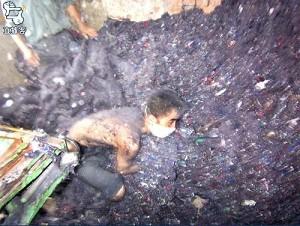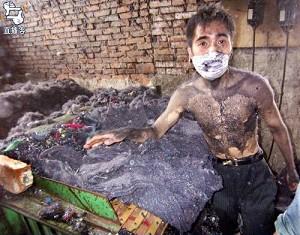In the wake of the heartbreaking story of underground brick factories involving scores of child slaves found in China’s Shanxi province, a similar exploitation has emerged: a corrupt cotton factory in Wuhan City, Hubei Province. In a darkened factory chamber several dark-skinned workers surrounded a large pile of contaminated cotton. Some workers lay exhaustedly on the factory’s grimy floor, their bodies covered with dark mosquitoes and flies. One of the workers raised his hand, which was dyed black from his labor, and revealed a damaged finger that had been cut off by a machine.
Photos of Exploited Workers
On July 7, Wang Haofeng, a former photojournalist for a Wuhan-based newspaper known for exposing hidden crimes, found the factory by chance. At his own risk, Wang snuck into the facility and shot some breathtaking photos that he later posted on his own personal web page—Wang Haofeng’s “Focus.” In his posting Wang included a call to save these exploited workers.
According to the Information Times , Wang revealed that the media actually exposed this factory in 2001. At that time the factory was accused of employing underage children who were tortured and denied pay. The story broke when the children escaped and the local government in Wuhan fined and condemned the facility. But despite media exposure and police intervention, the factory soon resumed its old ways, and has secretly remained in operation until now.

Since its initial exposure, circumstances have grown even worse for factory workers. Composed of five or six enclosed brick chambers, the factory resembles a dark tomb. The facility lacks windows, lights and fans, making for suffocating, hot and stuffy working conditions, particularly in Wuhan, which is notorious for its unbearably hot summer. The chambers are hazy with dust that irritates the nose, eyes and throat. No person would stay inside this facility of his own free will.
Due to the extreme temperatures, nearly all workers labored naked from the waist up. Just like the contaminated cotton that they dealt with, the worker’s bodies were dyed black—each of them was black from head to toe. The white surgeon’s mask worn by one worker revealed black marks at his mouth and nostrils. One could clearly see that the air inside the chamber was dirty and smoke-saturated. One very young laborer looked to have been responsible for processing the various colors of collected worn-out cloth. His many hours spent in the factory had dyed his hair a lifeless pale red, like dead grass. It was quite painful to rest eyes on this ruined youth.

During his secret investigation, Wang talked to one worker who showed him a damaged finger, explaining that his finger had been cult off by a machine in the factory. “The boss is quite cruel,” the worker told Wang, “Since I entered this factory, I have become thinner and there is great pain in my chest when I breathe.” Soon after the worker finished his words, a man who appeared to be a supervisor showed up, pointing a long sharp knife at Wang. Another supervisor shouted, “If you dare to take photos, I will beat you to death!” Meanwhile, another man who appeared to be running the operation came forward to give the worker a tongue-lashing “Why did you talk to an outsider?!” he shouted.
When recounting how he managed to come out of the factory in one piece, Wang said with a smile, “It was really a narrow escape.” The armed supervisor grabbed Wang’s camera, yet when he checked it he found that no photos had been taken. Cleverly, Wang brought several cameras with him and the supervisor never found the camera that had actually been used to document the facility. When the supervisor saw that no photo was taken, he promptly threw Wang out.
Because of his close brush with the angry supervisors, Wang did not have enough time to observe the other chambers in the factory. Therefore, he could not accurately determine just how many laborers there were in the facility. But he did spot over ten workers in the chamber when he first arrived.
This exploitative cotton factory was located next to a funeral parlor in Hankou, Wuhan City. Most of its ingredients came from the used and dirty cotton cloth retrieved from the funeral parlor’s garbage.




